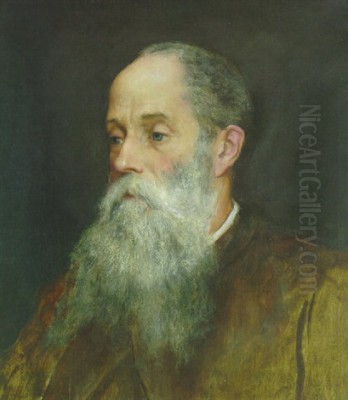
John Roddam Spencer Stanhope stands as a significant, if sometimes overlooked, figure in the rich tapestry of nineteenth-century British art. Born into an aristocratic milieu yet drawn to the bohemian and idealistic world of the Pre-Raphaelites, Stanhope forged a unique artistic path. His work, characterized by its lyrical beauty, meticulous detail, and profound engagement with mythological and spiritual themes, reflects both the artistic currents of Victorian England and a deep, personal connection to the art of the Italian Renaissance. This exploration delves into the life, influences, collaborations, and enduring legacy of an artist whose canvases transport viewers to realms of dreamlike enchantment.
Early Life and Aristocratic Roots
John Roddam Spencer Stanhope was born on January 20, 1829, in Yorkshire, England, into a family of considerable social standing. His birthplace, Cannon Hall, near Barnsley, was a testament to his family's landed gentry status. His father, John Spencer Stanhope, was a classical antiquarian and explorer, and his mother, Elizabeth Wilhelmina Coke, was the daughter of Thomas William Coke, 1st Earl of Leicester of Holkham. This lineage provided young Stanhope with a privileged upbringing, steeped in culture and intellectual pursuits. The family's connections were extensive; notably, his mother and aunt had received artistic instruction from the eminent eighteenth-century portraitist Thomas Gainsborough, suggesting an early familial appreciation for the arts.
This environment undoubtedly fostered Stanhope's nascent artistic inclinations. While details of his earliest artistic training are somewhat sparse, it is known that he attended Oxford University. It was during this period, and shortly thereafter, that his path would decisively turn towards a professional career in painting, moving away from the more conventional pursuits expected of a man of his class.
The Influence of George Frederic Watts
A pivotal moment in Stanhope's artistic development was his decision to study under George Frederic Watts. Watts, a towering figure in Victorian art, was renowned for his allegorical and symbolist paintings, often referred to as the "England's Michelangelo." Around 1850, Stanhope became Watts's pupil and assistant, a relationship that would prove deeply formative. Watts's emphasis on serious, high-minded subjects, his rich color palette, and his admiration for Italian Renaissance masters, particularly Titian and Michelangelo, resonated with Stanhope.
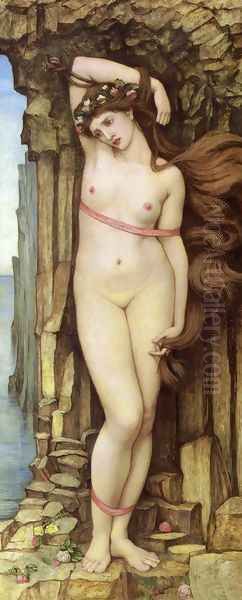
Under Watts's tutelage, Stanhope honed his technical skills and absorbed an approach to art that valued intellectual depth and moral purpose. In 1853, he accompanied Watts on a significant journey to Italy, a trip that would further cement his love for Italian art and landscape. They also travelled to Asia Minor, broadening Stanhope's visual and cultural experiences. This period of close association with Watts provided Stanhope with not only artistic guidance but also an entry into the vibrant artistic circles of London.
Immersion in the Pre-Raphaelite Brotherhood
Through Watts, Stanhope was introduced to the leading figures of the Pre-Raphaelite Brotherhood and their associates. The Pre-Raphaelite movement, initiated in 1848 by William Holman Hunt, John Everett Millais, and Dante Gabriel Rossetti, sought to revitalize British art by rejecting the perceived academicism of the Royal Academy and embracing the sincerity, bright colors, and detailed naturalism of early Italian art before Raphael.
Stanhope became closely involved with the "second wave" of Pre-Raphaelitism, which emerged in the mid-1850s and was particularly associated with Edward Burne-Jones and William Morris. A crucial collaborative project that solidified these connections was the decoration of the Oxford Union Debating Hall in 1857. Dante Gabriel Rossetti, a charismatic leader, gathered a group of young artists, including Stanhope, Burne-Jones, Morris, Val Prinsep, Arthur Hughes, and John Hungerford Pollen, to paint murals based on Arthurian legends from Malory's "Morte d'Arthur."
Stanhope's contribution was "Sir Gawaine and the Damsels at the Fountain." Although the murals were technically flawed due to the artists' inexperience with fresco and the improper preparation of the walls, leading to their rapid deterioration, the project was a significant moment of camaraderie and artistic exchange. It cemented Stanhope's place within this avant-garde group and exposed him directly to the romantic medievalism and decorative richness that characterized much of their work. His friendship with Burne-Jones, in particular, would be enduring and mutually influential.
Artistic Style: A Synthesis of Influences
Stanhope's artistic style evolved into a distinctive blend of Pre-Raphaelite intensity, Watts's classicism, and a profound personal affinity for the art of the Early Italian Renaissance, particularly painters like Sandro Botticelli and Fra Angelico. His works are characterized by their dreamlike, often melancholic, atmosphere. He favored elongated, graceful figures, often clad in flowing draperies reminiscent of Florentine Quattrocento painting.
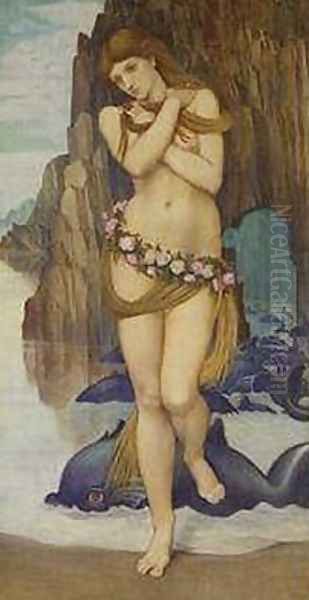
His color palettes are typically rich and jewel-like, with a careful attention to harmonious combinations. Detail, a hallmark of Pre-Raphaelitism, is evident in his rendering of foliage, textiles, and architectural elements, yet it is often subsumed within a broader decorative and poetic effect rather than a strict adherence to scientific naturalism. Symbolism is a key component of his art; his subjects, whether drawn from mythology, religion, or literature, are imbued with layers of meaning, inviting contemplation. He worked proficiently in various media, including oil, watercolor, and fresco, and sometimes utilized mixed media to achieve specific textural effects.
Major Themes and Subjects
Stanhope's oeuvre explores a range of themes that were popular among Victorian artists, yet he approached them with a unique sensibility. Mythological subjects, particularly from Greek legends, feature prominently. These were not mere illustrations but rather vehicles for exploring universal human emotions and allegorical concepts. Works such as Andromeda and Venus Rising from the Sea demonstrate his engagement with classical narratives, often reinterpreted through a romantic and aesthetic lens.
Religious themes also occupied a significant place in his work. He painted biblical scenes like The Annunciation and created devotional pieces, including altarpieces and murals for churches. His religious art often possesses a quiet sincerity and a decorative beauty that aligns with the more aesthetic wing of the Pre-Raphaelite movement. He also explored contemporary themes, though often imbued with a sense of timelessness or allegory, as seen in paintings like Thoughts of the Past. This painting, depicting a contemplative woman by a window overlooking the Thames, touches on themes of memory, loss, and the fallen woman, common concerns in Victorian society and art.
Key Works: "Love and the Maiden" and Others
Among Stanhope's most celebrated works is Love and the Maiden, painted in 1877. This large canvas, now in the collection of the Fine Arts Museums of San Francisco, is considered a quintessential example of his mature style. It depicts a group of young women in an idyllic, flower-strewn landscape, encountering the winged figure of Love (Eros). The composition is elegant, the figures graceful, and the mood one of gentle melancholy and poetic reverie. The painting showcases Stanhope's mastery of color, his debt to Italian Renaissance art (particularly Botticelli), and his ability to create a self-contained, dreamlike world.
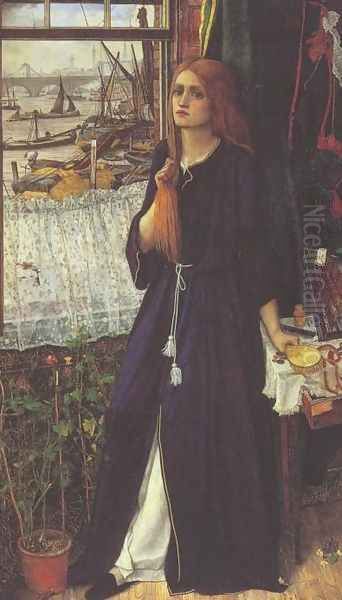
Another significant work is Penelope (exhibited 1864), depicting the faithful wife of Odysseus at her loom, a subject that allowed for the exploration of themes of patience, longing, and domestic virtue, all rendered with Stanhope's characteristic attention to decorative detail and emotional nuance. Our Lady of the Water Gate (1870) is a notable example of his religious painting, imbued with a serene, devotional quality. His mural work, though less portable, was also important, such as the reredos for the private chapel at Marlborough College and decorations for the Holy Trinity Church in Florence.
The Florentine Connection: A New Home and Inspiration
Stanhope suffered from chronic asthma, and the damp climate of England exacerbated his condition. Seeking a more congenial environment, he began to spend more time in Italy. In 1873, he purchased the Villa Nuti in Bellosguardo, near Florence, a city that had long captivated him with its artistic heritage. By 1880, he had made Florence his permanent home, though he continued to exhibit his work in London, primarily at the Grosvenor Gallery and later the New Gallery, venues favored by artists associated with the Aesthetic Movement.
The move to Florence was profoundly significant for his art. Surrounded by the masterpieces of the Renaissance and the sun-drenched Tuscan landscape, his style gained further refinement and a deeper connection to Italianate forms and light. The Villa Nuti became a gathering place for expatriate artists and intellectuals. Living in Florence allowed him to immerse himself fully in the artistic atmosphere that had always been a primary source of inspiration. He became an integral part of the Anglo-Florentine artistic community, which included figures like his niece, Evelyn De Morgan (née Pickering), who also spent considerable time in Italy and whose work shares some stylistic affinities with her uncle's.
Personal Life: Family and Tragedy
In 1859, Stanhope married Elizabeth King, daughter of John James King. They had one daughter, Mary Spencer Stanhope, born in 1860. Tragically, Mary died of scarlet fever in 1867 at the age of six. This devastating loss undoubtedly cast a shadow over Stanhope's life and may have contributed to the melancholic undertones present in much of his art. His wife, Elizabeth, passed away in 1891. Stanhope designed a memorial for his daughter in the English Cemetery in Florence, a testament to his enduring grief and his artistic engagement even in personal sorrow.
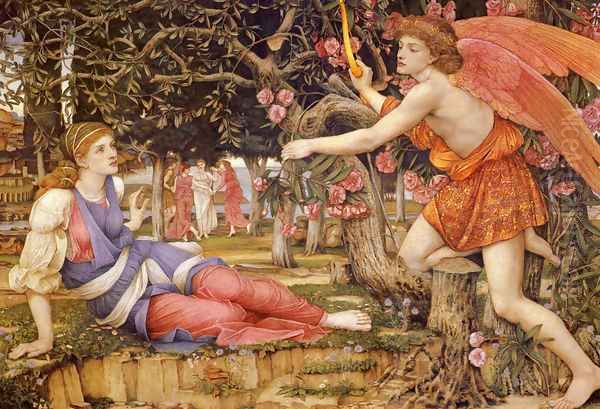
His family connections extended into the art world beyond his immediate household. His sister, Mary Gertrude Spencer Stanhope, was a sculptor. More famously, his niece, Evelyn Pickering, who later married the ceramicist William De Morgan, became a prominent artist in her own right. Evelyn De Morgan is recognized as a leading figure of the later Pre-Raphaelite and Symbolist movements, and her uncle's influence, particularly his rich color sense and mythological themes, is discernible in her work. Stanhope actively encouraged her artistic pursuits.
Contemporaries and Artistic Milieu
Stanhope's career spanned a period of dynamic change in the British art world. Beyond his close association with the Pre-Raphaelites like Burne-Jones, Rossetti, and Morris, he was a contemporary of other significant Victorian artists. These included figures associated with the Aesthetic Movement, such as Frederic Leighton, Albert Moore, and James McNeill Whistler, who emphasized "art for art's sake," prioritizing beauty and formal qualities over narrative or overt moralizing. While Stanhope's work retained a strong narrative and symbolic element, its decorative qualities and pursuit of beauty aligned with certain aspects of Aestheticism.
He exhibited alongside many of these artists at the Grosvenor Gallery, established in 1877 by Sir Coutts Lindsay and his wife Blanche. The Grosvenor Gallery provided an alternative to the Royal Academy, showcasing more progressive and avant-garde art. Stanhope was a regular exhibitor there, and his works were generally well-received, appreciated for their poetic charm and distinctive style. Other artists whose work might have been seen alongside Stanhope's, or who shared similar thematic interests, include Walter Crane, known for his illustrative and decorative work, and Simeon Solomon, whose art explored classical and biblical themes with a sensuous, aesthetic quality. The broader artistic landscape also included more academic painters like Sir Edward Poynter and Lawrence Alma-Tadema, who specialized in meticulously rendered scenes of classical antiquity, though Stanhope's approach was generally more poetic and less archaeological.
Later Years and Continued Artistic Production
Even after relocating permanently to Florence, Stanhope remained an active artist. He continued to produce easel paintings, often sending them back to England for exhibition. His Florentine studio became a hub of creativity, and he undertook commissions for local churches, including an altarpiece for the English Church (Holy Trinity) in Florence. His commitment to his art remained unwavering throughout his life.
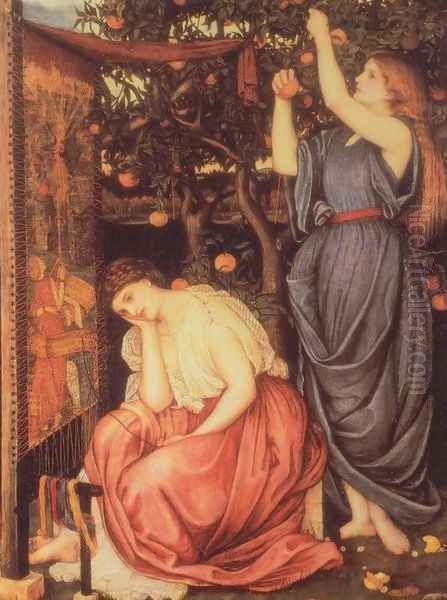
His later works retain the hallmarks of his established style: the rich colors, the graceful figures, and the dreamlike atmosphere. However, there is perhaps an even greater sense of serenity and a deeper immersion in the Italianate aesthetic, a natural consequence of his long residence in Tuscany. He continued to explore mythological and religious subjects, finding in them an inexhaustible source of inspiration. The influence of Italian masters like Ghirlandaio or Filippino Lippi can sometimes be felt in the compositions and figure types of his later paintings.
Legacy and Historical Impact
John Roddam Spencer Stanhope's contribution to British art lies in his unique synthesis of Pre-Raphaelite ideals with a profound love for the Italian Renaissance, filtered through a distinctly personal and poetic sensibility. He was a key figure in the "second generation" of Pre-Raphaelitism, helping to carry its aesthetic concerns into the later Victorian period and into the emerging Symbolist movement.
His influence on his niece, Evelyn De Morgan, is a significant part of his legacy, as she became one of the most important female artists of the era, continuing the exploration of spiritual and mythological themes with a powerful, individual style. Stanhope's dedication to craftsmanship, his rich use of color, and his ability to create evocative, dreamlike worlds set his work apart.
While perhaps not as widely known today as some of his more famous contemporaries like Rossetti or Burne-Jones, Stanhope's paintings are increasingly appreciated for their unique charm and artistic merit. His works can be found in major public collections, including Tate Britain, the Ashmolean Museum in Oxford, the Birmingham Museum and Art Gallery, and various museums in the United States. Art historians recognize him as an important link between the Pre-Raphaelite Brotherhood, the Aesthetic Movement, and British Symbolism. His decision to live and work in Florence also highlights the enduring allure of Italy for British artists and the cross-cultural exchanges that enriched Victorian art.
Conclusion: An Enduring Vision
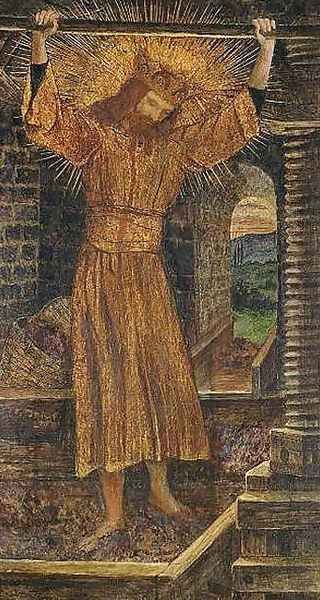
John Roddam Spencer Stanhope passed away in Florence on August 2, 1908, at the age of 79. He left behind a body of work that continues to captivate with its lyrical beauty, its imaginative power, and its heartfelt engagement with the great themes of art and life. From the rebellious fervor of the Oxford Union murals to the serene, sun-drenched canvases of his Florentine years, Stanhope remained true to his artistic vision. He successfully navigated the complex currents of Victorian art, creating a distinctive niche for himself as a painter of dreams, myths, and spiritual allegories. His art serves as a beautiful bridge between the romantic medievalism of the early Pre-Raphaelites and the more introspective, symbolic concerns of the fin de siècle, all infused with the timeless grace of the Italian Renaissance. As a dedicated artist and a gentle visionary, John Roddam Spencer Stanhope's contributions enrich our understanding of the diverse and fascinating landscape of nineteenth-century art.